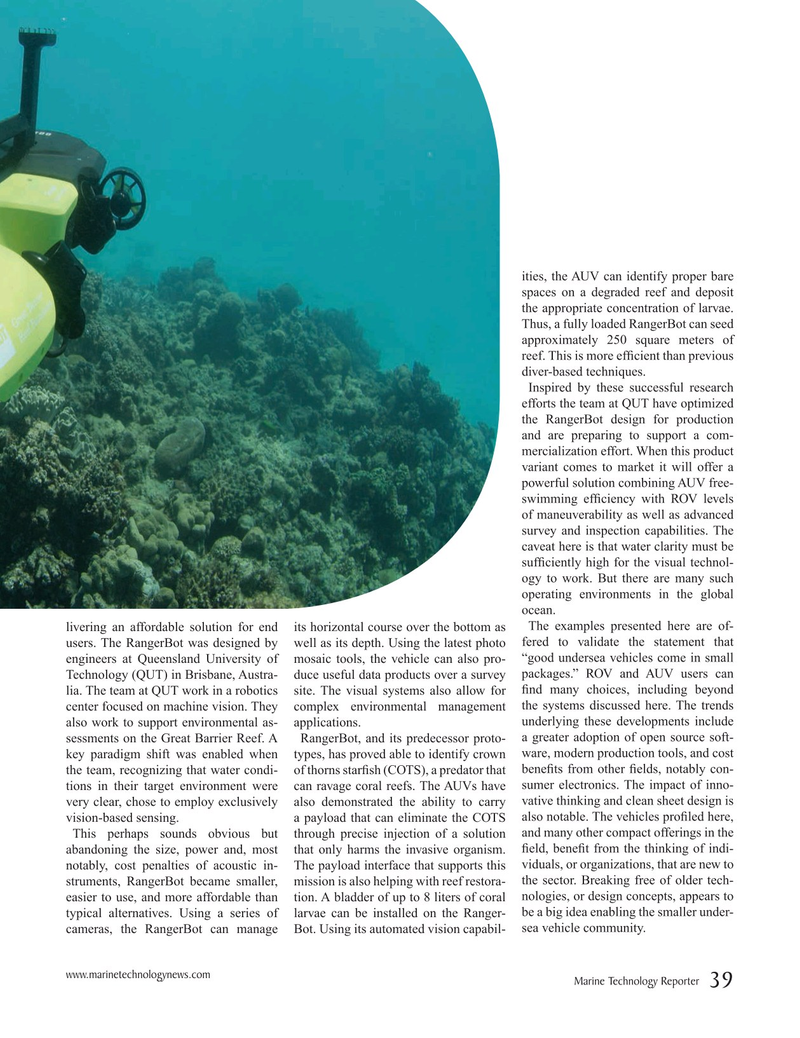
Page 39: of Marine Technology Magazine (January 2020)
Read this page in Pdf, Flash or Html5 edition of January 2020 Marine Technology Magazine
ities, the AUV can identify proper bare spaces on a degraded reef and deposit the appropriate concentration of larvae.
Thus, a fully loaded RangerBot can seed approximately 250 square meters of reef. This is more ef? cient than previous diver-based techniques.
Inspired by these successful research efforts the team at QUT have optimized the RangerBot design for production and are preparing to support a com- mercialization effort. When this product variant comes to market it will offer a powerful solution combining AUV free- swimming ef? ciency with ROV levels of maneuverability as well as advanced survey and inspection capabilities. The caveat here is that water clarity must be suf? ciently high for the visual technol- ogy to work. But there are many such operating environments in the global ocean.
livering an affordable solution for end its horizontal course over the bottom as The examples presented here are of- users. The RangerBot was designed by well as its depth. Using the latest photo fered to validate the statement that engineers at Queensland University of mosaic tools, the vehicle can also pro- “good undersea vehicles come in small
Technology (QUT) in Brisbane, Austra- duce useful data products over a survey packages.” ROV and AUV users can lia. The team at QUT work in a robotics site. The visual systems also allow for ? nd many choices, including beyond center focused on machine vision. They complex environmental management the systems discussed here. The trends also work to support environmental as- applications. underlying these developments include sessments on the Great Barrier Reef. A RangerBot, and its predecessor proto- a greater adoption of open source soft- key paradigm shift was enabled when types, has proved able to identify crown ware, modern production tools, and cost the team, recognizing that water condi- of thorns star? sh (COTS), a predator that bene? ts from other ? elds, notably con- tions in their target environment were can ravage coral reefs. The AUVs have sumer electronics. The impact of inno- very clear, chose to employ exclusively also demonstrated the ability to carry vative thinking and clean sheet design is vision-based sensing. a payload that can eliminate the COTS also notable. The vehicles pro? led here,
This perhaps sounds obvious but through precise injection of a solution and many other compact offerings in the abandoning the size, power and, most that only harms the invasive organism. ? eld, bene? t from the thinking of indi- notably, cost penalties of acoustic in- The payload interface that supports this viduals, or organizations, that are new to struments, RangerBot became smaller, mission is also helping with reef restora- the sector. Breaking free of older tech- easier to use, and more affordable than tion. A bladder of up to 8 liters of coral nologies, or design concepts, appears to typical alternatives. Using a series of larvae can be installed on the Ranger- be a big idea enabling the smaller under- cameras, the RangerBot can manage Bot. Using its automated vision capabil- sea vehicle community. www.marinetechnologynews.com
Marine Technology Reporter 39
MTR #1 (34-49).indd 39 1/16/2020 11:41:34 AM

 38
38

 40
40
